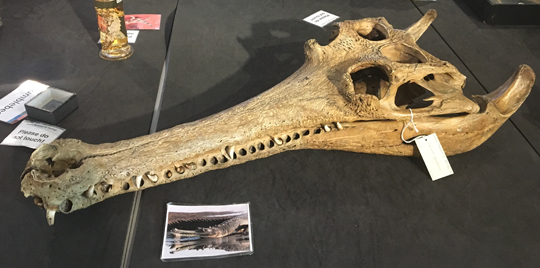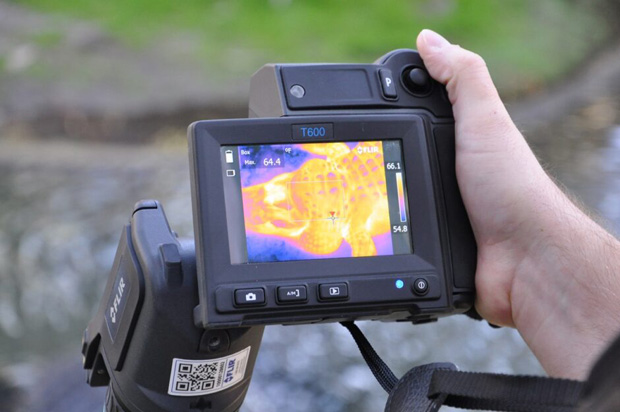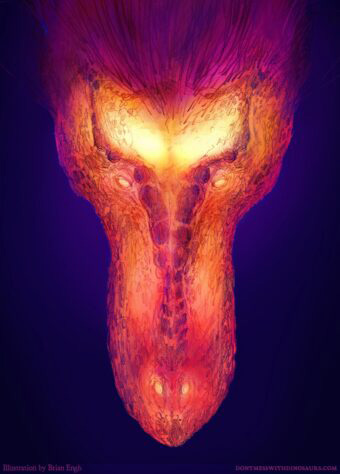T. rex and Air-conditioning a New Study
T. rex had “Air Conditioning”
Scientists from the University of Missouri, Ohio University and the University of Florida have turned a theory about Tyrannosaurus rex (and other archosaurs for that matter), on its head. Previously, palaeontologists had thought that two large holes in the roof of the skull of T. rex (the dorsotemporal fenestra), were filled with muscles to assist with movement of the jaws. However, a thermal imaging study of extant archosaurs, specifically American alligators at the St Augustine Alligator Farm Zoological Park (Florida), has led the researchers to suggest that these skull holes played a role in helping this huge animal to regulate its temperature.
T. rex with Air-conditioning
The team, which included Larry Witmer, a professor of anatomy at Ohio University, conclude that, in essence T. rex had an air-conditioning unit in its head.
An Imagined Thermal Image Taken in the Cretaceous Night

Picture credit: Brian Engh
Helping to Regulate Body Temperature
Lead author of the scientific paper, published in the journal “The Anatomical Record”, Professor Casey Holliday was puzzled by the idea that these skull holes were associated with muscle attachments. The Professor of anatomy at the Missouri University School of Medicine commented:
“It’s really weird for a muscle to come up from the jaw, make a 90-degree turn, and go along the roof of the skull. Yet, we now have a lot of compelling evidence for blood vessels in this area, based on our work with alligators and other reptiles.”
The researchers used thermal imaging cameras to examine alligators in captivity and they believe that these living archosaurs can provide key insights into the anatomy of their long dead, cousins the Dinosauria.
A Thermal Image of the “Hot Spots” on the Head of an American Alligator
Picture credit: University of Missouri
Studying American Alligators
Explaining the significance of this new study, co-author Kent Vliet (University of Florida), stated:
“An alligator’s body heat depends on its environment. Therefore, we noticed when it was cooler and the alligators are trying to warm up, our thermal imaging showed big hot spots in these holes in the roof of their skull, indicating a rise in temperature. Yet, later in the day when it’s warmer, the holes appear dark, like they were turned off to keep cool. This is consistent with prior evidence that alligators have a cross-current circulatory system — or an internal thermostat, so to speak.”
If the dorsotemporal fenestra of theropods such as Tyrannosaurus rex were also lined with blood vessels then these holes could have played a role in helping dinosaurs to control their body temperatures. For such a big animal, the problem might not be trying to keep warm, but actually the avoidance of overheating. The blood vessels occupying the dorsotemporal fenestra would have been covered by skin and the proximity of these vessels to the outside environment might have helped T. rex to lose heat.
An Speculative Thermal Image (Dorsal View) Showing the Head of T. rex
Picture credit: Brian Engh
Prominent Dorsotemporal Fenestra
T. rex and alligators have similar holes in the top of their head. By studying the anatomy of living animals, scientists can gain valuable insights into the anatomy of long extinct relatives such as the dinosaurs.
The Skull of a Gharial Showing Two Large, Prominent Dorsotemporal Fenestra

Picture credit: Everything Dinosaur
Everything Dinosaur acknowledges the assistance of a press release from the University of Missouri in the compilation of this article.
The scientific paper: “The Frontoparietal Fossa and Dorsotemporal Fenestra of Archosaurs and Their Significance for Interpretations of Vascular and Muscular Anatomy in Dinosaurs” by Casey M. Holliday, William Ruger Porter, Kent A. Vliet and Lawrence M. Witmer published in the journal The Anatomical Record.
The Everything Dinosaur website: Everything Dinosaur.



